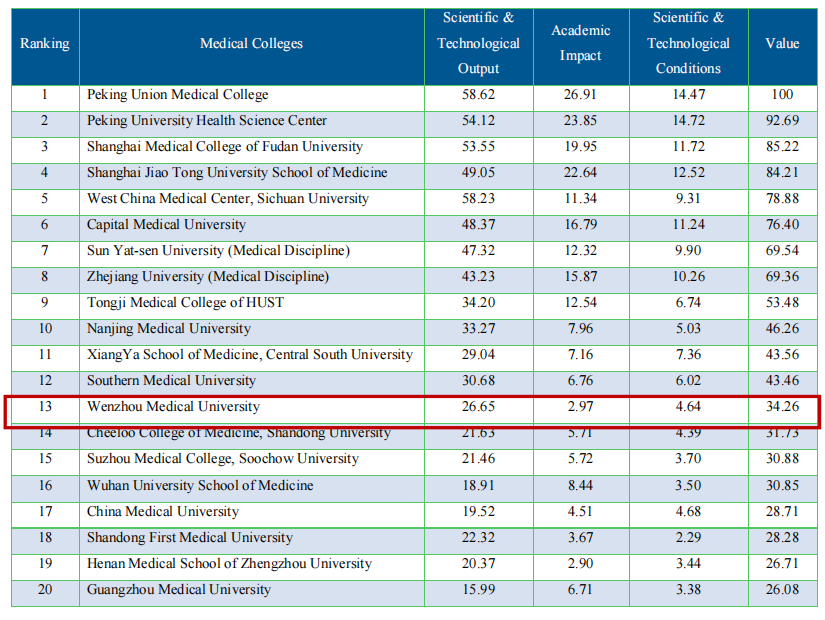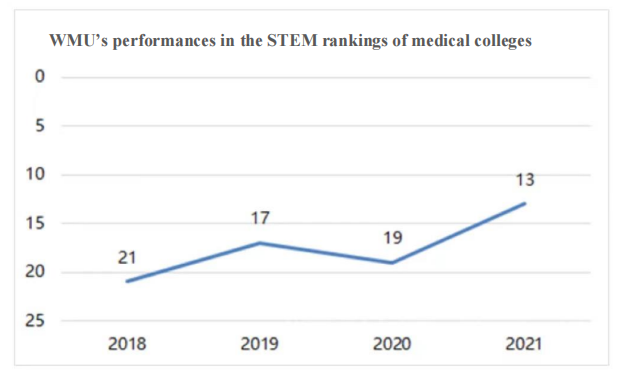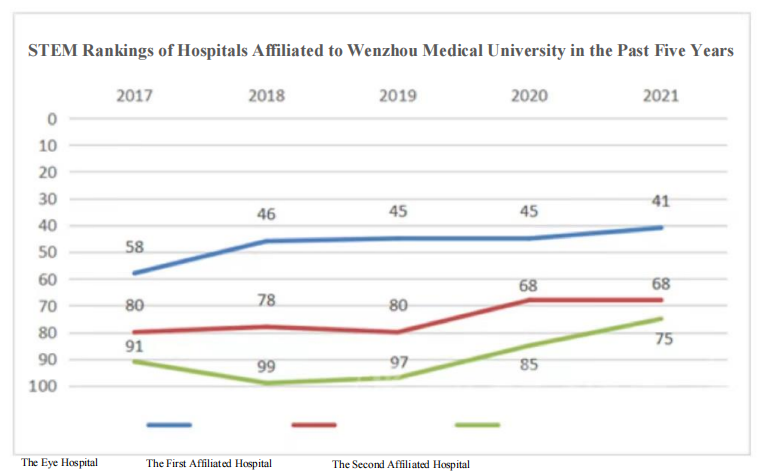- WMU reaches new peak in the 2021 Chinese Medical Colleges and Chinese Hospitals Science and Technology Evaluation Metrics (STEM)
- Author:Technology Department Date:August 18, 2022
On August 4, the Chinese Academy of Medical Sciences released the "2021 Science and Technology Evaluation Metrics (STEM) and Accumulative Science and Technology Evaluation Metrics (ASTEM) of Chinese Medical Colleges/Chinese Hospitals". WMU ranks 13th in the STEM rankings of Chinese medical colleges, up by six places from 2020, reaching a new peak. The university ranks the fourth place among medical colleges jointly built by the National Health Commission and provincial governments. In the STEM rankings of Chinese hospitals, there are three hospitals affiliated to WMU ranking among the top 100. Among them, the affiliated Eye Hospital ranks 41st nationally, topping all eye hospitals in China for four consecutive years; the First Affiliated Hospital ranks 68th, the same as last year; the Second Affiliated Hospital ranks 75th, showing an improvement of 10 places compared with last year. In the ASTEM rankings of Chinese hospitals, the affiliated Eye Hospital, the First Affiliated Hospital, and the Second Affiliated Hospital rank 43rd, 70th, and 74th respectively.
2021 Science and Technology Evaluation Metrics (STEM) of Chinese medical colleges


In the 31 national top 100 rankings by disciplines, the Eye Hospital ranks the second place in ophthalmology; two disciplines of the First Affiliated Hospital enter the top ten – 5th in plastic surgery and 10th in burn surgery; the Second Affiliated Hospital ranks the 7th place in anesthesiology. The First Affiliated Hospital and the Second Affiliated Hospital have 27 and 22 disciplines shortlisted respectively. The First Affiliated Hospital ranks 13th in emergency medicine, 16th in critical care medicine, and 18th in gastroenterology. The Second Affiliated Hospital ranks 14th in pediatrics and 15th in orthopedics.



It is reported that STEM represents the overall scientific and technological strength of an institution, showing its capacity for scientific and technological innovation and sustainable development. Since innovating the concept of Science and Technology Evaluation Metrics (STEM) for the first time in 2018, the Chinese Academy of Medical Sciences has continuously enriched the science and technology evaluation metrics, scientifically determined the standards, improved the data quality, and continued to enhance the orientation of evaluation results. In 2019, the Chinese Medical Colleges Science and Technology Evaluation Metrics was developed for the first time. This year, the five-year Chinese Hospitals and Medical Colleges Accumulative Science and Technology Evaluation Metrics (ASTEM) was established and released for the first time, which combines short-term evaluation and long-term evaluation and better reflects the long-term and stable scientific research strength of institutions.
In recent years, under the leadership of the Party committee of the university, the scientific and technological work at WMU has focused on enhancing overall innovation capacity and set sight on the country’s major strategic needs and the frontier of global science and technology. Driven by solving major clinical problems, WMU has strived to build an organizational model and ecosystem for medical science and technology innovation, and carried out a number of major national scientific and technological projects such as the National Key Research and Development Program project on "Stem Cell Research and Organ Repair". The university has optimized the strategic goal of performance evaluation by taking "quality, performance, contribution" as the core orientations, incubated high-quality scientific and technological achievements, and achieved breakthroughs in paper publications in top journals such as JAMA and NATURE. The university has targeted original innovation in frontier sectors such as artificial intelligence, life sciences and healthcare, put the two-way link between basic research, clinical research, translational research and industrialization on a fast track, stimulated the clinical practice and application potential of affiliated hospitals, and realized high-quality commercialization of scientific and technological achievements such as "methods and drug compositions for the treatment of myopia". In addition, WMU has promoted the planning of high-level platforms to support the development of disciplines and established the National Engineering Research Center for Growth Factor Drugs and Protein Preparations of the National Development and Reform Commission, and the Key Laboratory for Clinical Research and Evaluation of Medical Devices and Drugs for Ophthalmic Diseases of the National Medical Products Administration, providing strong scientific and technological support for the establishment of a "double first-class" medical university.
Text translated by Zhang Kaiyue and reviewed by Sun You.
